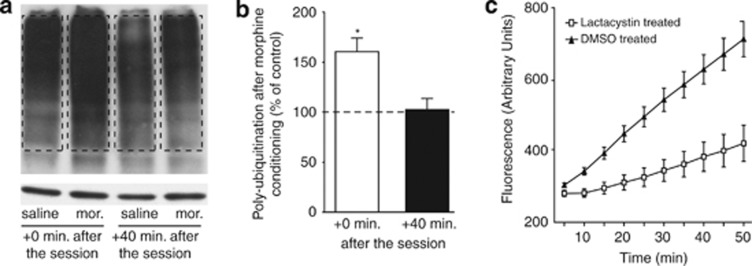Figure 1.
A single morphine conditioning increases synaptosomal poly-ubiquitination rate in the NAcc. (a, b) Mice were injected i.p. with 10 mg/kg morphine or saline and placed in the CPP apparatus, as in a conditioning session. Protein poly-ubiquitination was evaluated in NAcc synaptosomes isolated immediately or 40 min after the session. (a) Representative western blot. Upper panel: ubiquitin bands over 55 kDa (dotted lines) were compared; lower panel: actin. (b) Data quantification. Morphine-treated mice showed an increase in synaptic proteins poly-ubiquitination (n=4) immediately, but not 40 min after the session (n=4). Data are expressed as the mean±SEM of percent change in poly-ubiquitination compared with saline-treated mice. (c) Mice were injected in the NAcc with lactacystin (100 pmol) in one side and 2% DMSO in the other side. One hour later, NAcc proteasome activity was measured by the rate of degradation of the fluorogenic substrate Leu-Leu-Val-Tyr-7-amino-4 methylcoumarin. A comparison between slopes of the linear part of the two curves reveals a significant inhibition of proteasome catalytic activity in lactacystin-injected NAcc (n=6, Mann Whitney test, p<0.041) of 59.28±17.01%. Data are expressed in counts of fluorescence (arbitrary unit) over time. *p<0.05.

